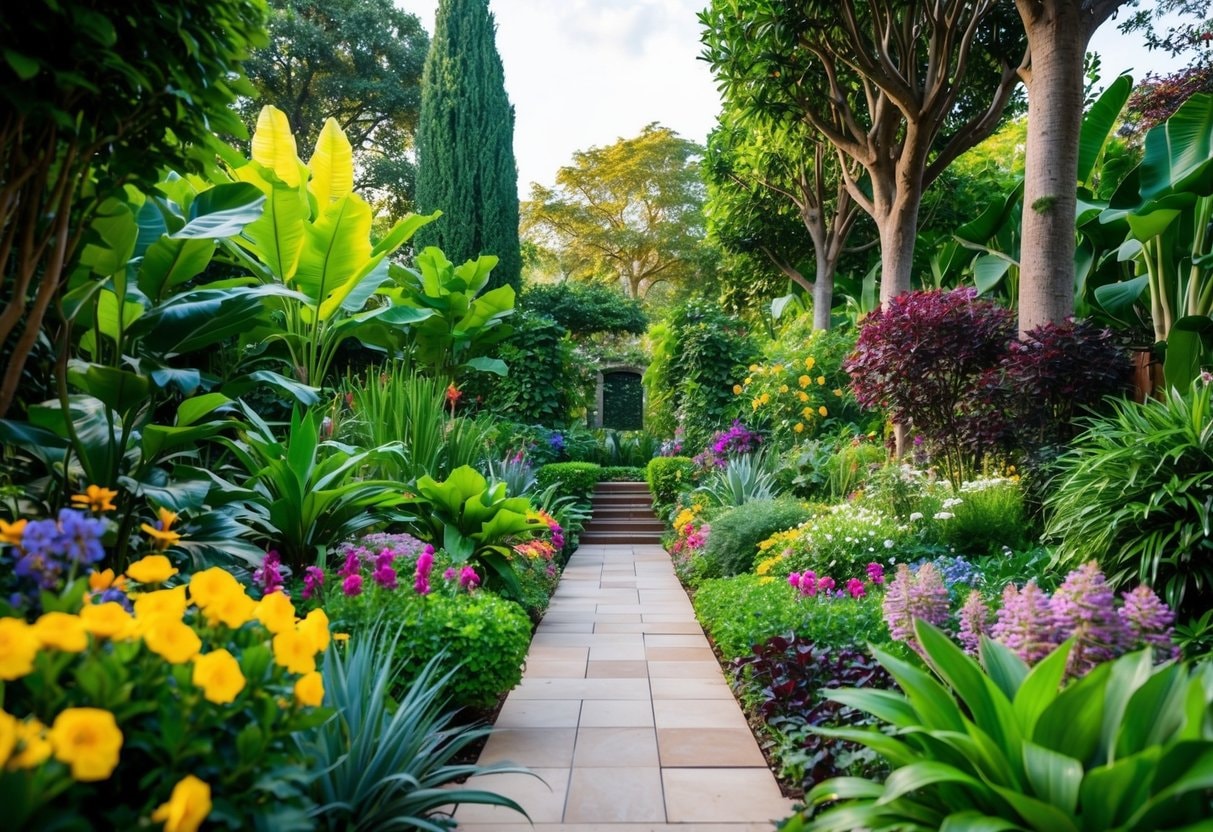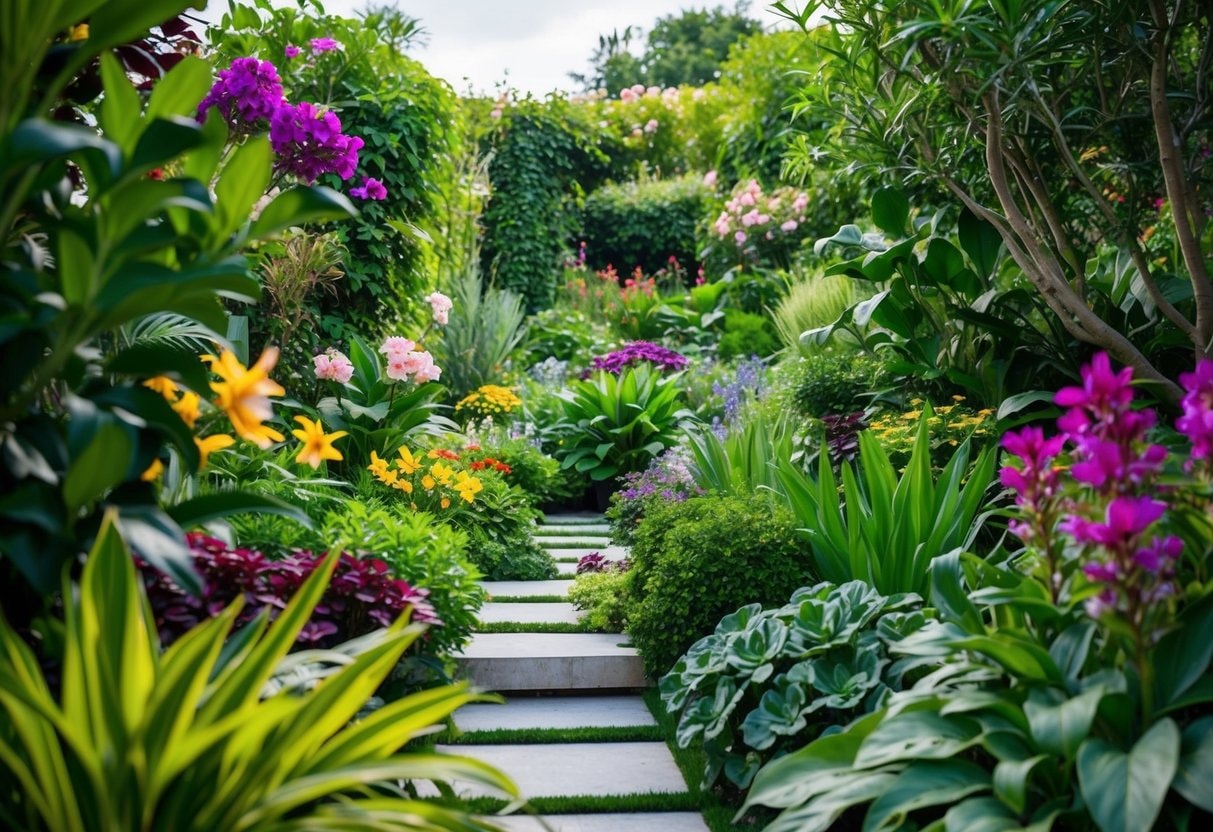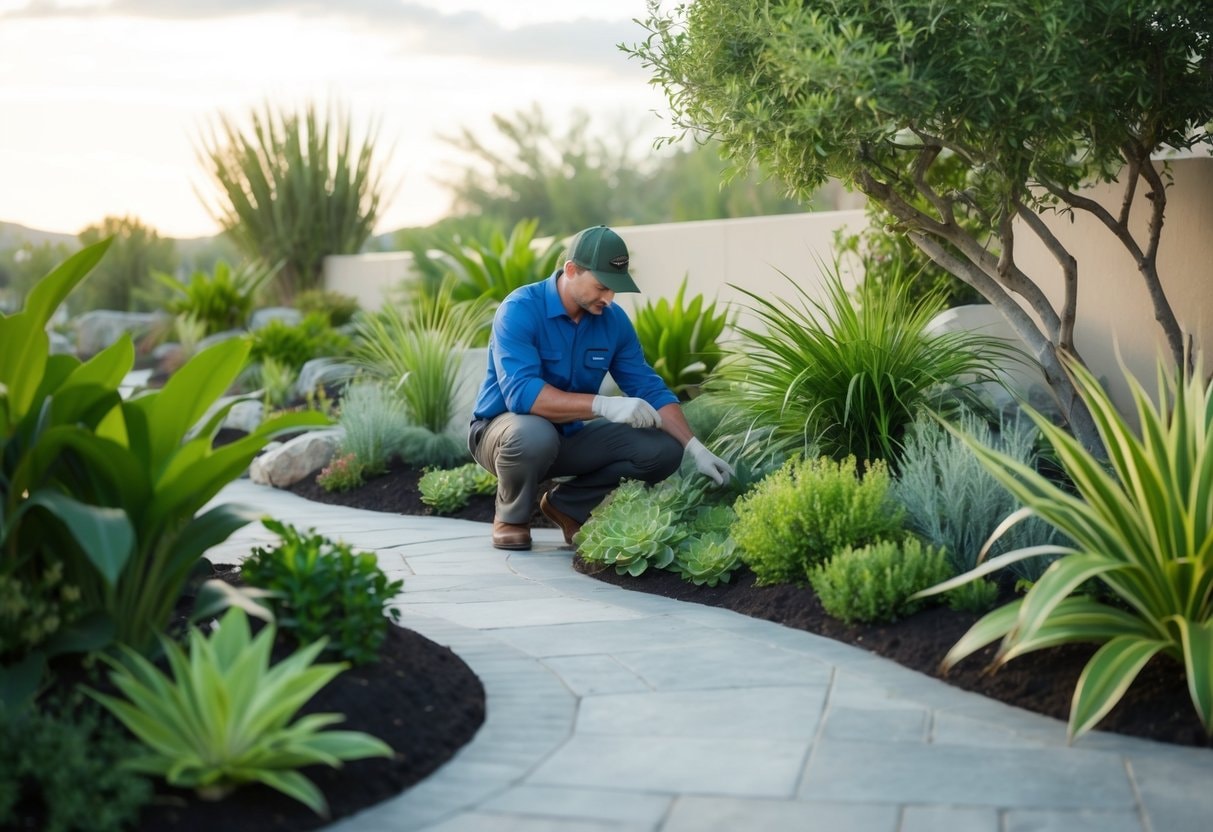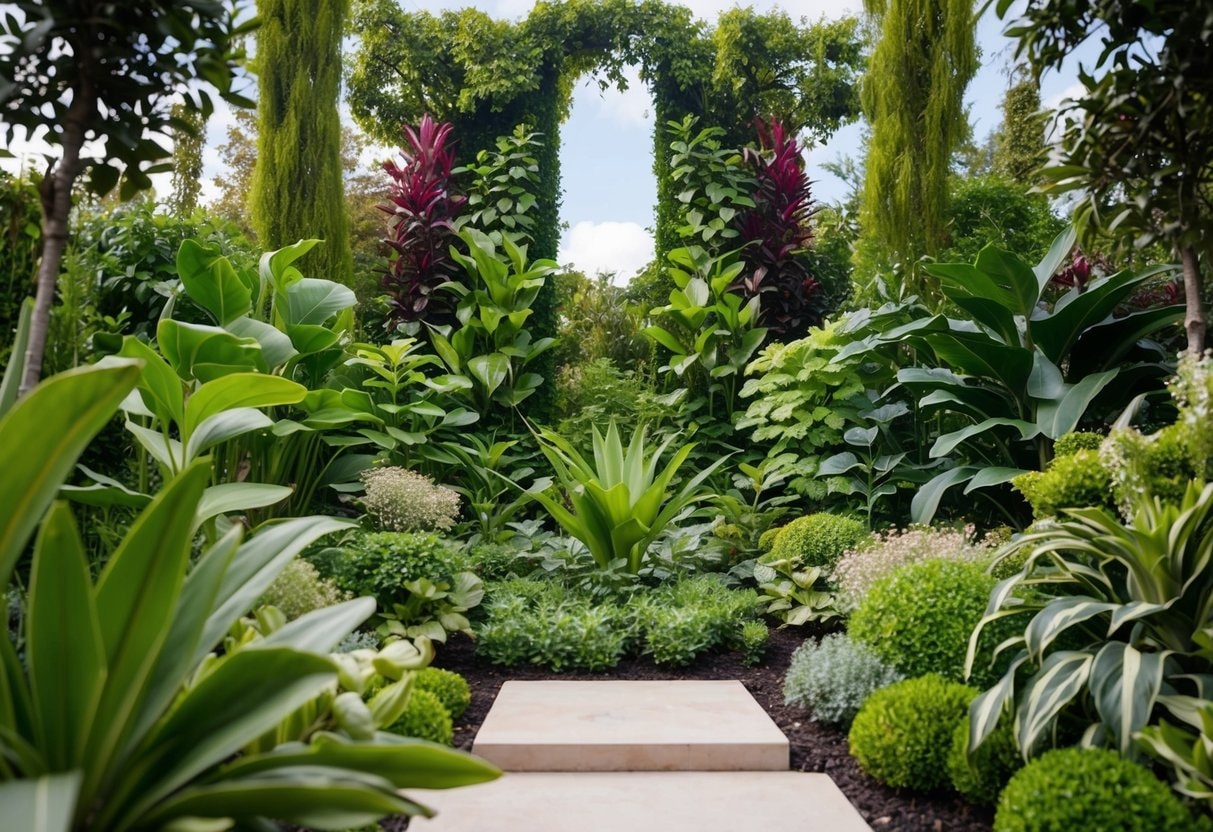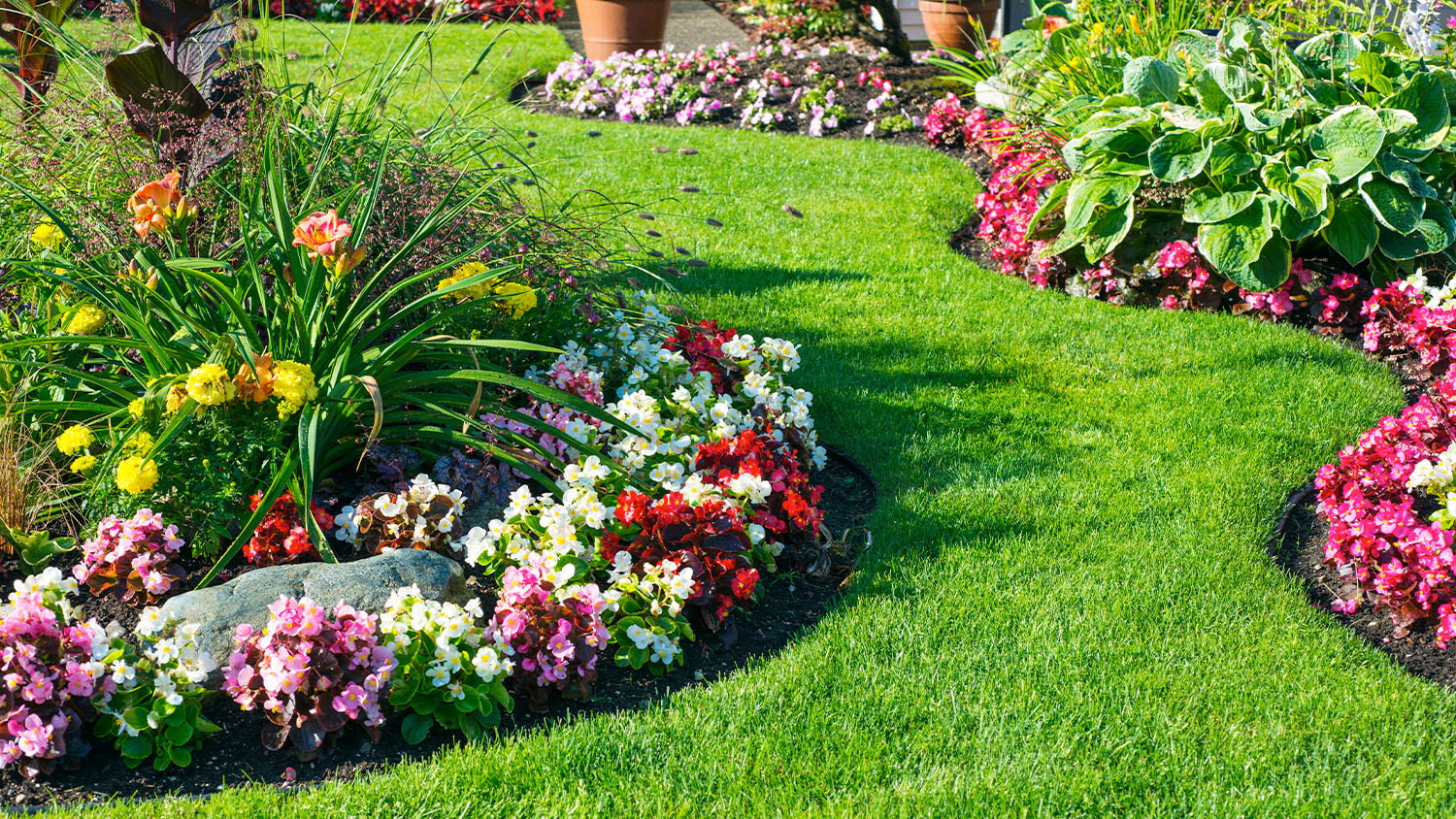HousePlantJoy is supported by our audience. When you purchase through one of our links, we may earn a small affiliate commission. As an Amazon Associate I earn from qualifying purchases. Your cost is not affected.
==================
Choosing the Right Plants is essential when creating your dream garden oasis. The perfect blend of greenery and blooms can transform any outdoor space into a serene retreat. By understanding climate, soil type, and plant needs, you can cultivate a garden that thrives year-round and reflects your style.
With thoughtful plant selection, your garden can become more than just a collection of plants—it can be a peaceful escape. Whether drawn to vibrant flowers or soothing foliage, the right choices will create a harmonious space where nature and tranquility meet.
Selecting the Perfect Plants: Crafting Your Garden Haven
Choosing the right plants is the first step to creating your dream garden. Your garden can be a calm, relaxing spot or a fun place to hang out with friends. The key is to match plants to your vision and your space. To choose the best plants for your garden, consider what you want it to look like and how much time you can take care of it. Do you want colorful flowers, tasty veggies, or leafy green plants? By choosing the right plants, you can ensure your garden thrives and reflects your style.
Each type needs different care and grows best in certain places. Before you buy any plants, check out your yard. Look at how much sun it gets and what soil you have. This will help you pick plants that will grow well in your space. Some plants like lots of sun, while others do better in shade. Knowing these things will help you make a garden that looks great and is easy to take care of.
Key Takeaways
- Before selecting plants, evaluate your yard’s sunlight, soil type, and climate. This ensures you choose plants that thrive in your specific conditions.
- Consider the purpose of your garden—whether for relaxation, food production, or gatherings—and select plants that align with this vision.
- Incorporate a variety of annuals, perennials, trees, shrubs, and groundcovers to create seasonal interest and a dynamic garden landscape.
- Choose plants based on your available time for care. Group plants with similar watering and care needs to simplify maintenance.
- Prioritize native species for easier growth and care, as they adapt well to local conditions and support local wildlife.
Envisioning Your Garden Oasis
Choosing the Right Plants is the first step in creating your perfect garden oasis. Start with a clear vision by considering what you want from your space and how it fits your lifestyle. Consider the local climate and how sunlight moves across your yard to ensure your plant choices thrive.
Defining the Purpose of Your Green Space
What do you want from your garden? A peaceful retreat? A place to grow food? Maybe a spot for outdoor gatherings? Your goal shapes everything else. For a calm hideaway, focus on comfy seating and soothing plants.
If you love to cook, plan for herb and veggie beds. For parties, make room for a grill and dining area. Mix uses to get more from your space. A small fountain can add peace to a patio. Climbing vines on a pergola give shade and beauty.
Visualizing the Layout and Theme
Picture how you’ll move through your garden. Where will paths go? What will catch your eye first? Sketch a basic layout of your space. Mark sunny and shady spots. Note any slopes or existing trees. This helps you place plants and features where they’ll thrive. Choose a theme that fits your style. Some ideas:
- Cottage Garden: Soft colors, flowing lines.
- Modern: Clean shapes, bold contrasts.
- Tropical: Lush greens, bright flowers.
- Zen: Simple lines, natural materials.
Your theme guides plant choices and decor. It helps create a unified look.
Considering the Climate and Exposure
Your local weather plays a big role in plant choices. Know your hardiness zone to pick plants that can handle your winters. Watch how the sun moves across your yard. Some spots may get full sun all day. Others might be shady most of the time. Match plants to these conditions.
Think about wind patterns too. A windy spot might need sturdy plants or a windbreak. A sheltered area could host more delicate blooms. Water is key. If you live somewhere dry, look for drought-tough plants. In wet areas, good drainage is a must.
Understanding Plant Varieties
Choosing the Right Plants is crucial because plants come in many types, each with unique characteristics and care needs. Knowing these differences helps you pick the right plants for your garden. Let’s look at the main plant varieties you’ll encounter.
Annuals, Perennials, and Biennials
Annuals complete their life cycle in one growing season. They bloom quickly and provide lots of color. You’ll need to replant them each year. Perennials live for many years. They often have a shorter bloom time but come back every spring. This saves you time and money on replanting.
Biennials take two years to complete their life cycle. They grow leaves in the first year and flower in the second. Some popular biennials are foxgloves and hollyhocks. When planning your garden, mix these types for year-round interest. Use annuals for quick color and perennials for long-term structure.
Trees, Shrubs, and Groundcovers
Trees are the backbone of your garden. They provide shade, privacy, and homes for wildlife. Choose trees based on their mature size and your available space. Shrubs are smaller, woody plants. They’re great for creating borders or focal points. Many shrubs offer beautiful flowers or colorful foliage.
Groundcovers spread to cover soil. They’re useful for slopes or areas where grass won’t grow. Some popular options are creeping thyme and vinca. When selecting these plants, consider their growth rate and maintenance needs. Carefully plan where to place them in your garden for the best effect.
Herbs, Vegetables, and Fruits
Herbs add flavor to your cooking and fragrance to your garden. Many are easy to grow in small spaces or containers. Popular choices include basil, rosemary, and mint. Vegetables let you enjoy fresh, home-grown produce. Start with easy crops like tomatoes or lettuce. As you gain experience, try more challenging plants.
Fruit plants can be trees, bushes, or vines. They offer both beauty and tasty rewards. Consider your climate when choosing fruit varieties. For a productive garden, group plants with similar needs together. This makes watering and care easier. Don’t forget to include pollinator-friendly plants to help your fruits and vegetables thrive.
Choosing The Right Plants: Site Preparation and Soil Considerations
Getting your garden ready is key to growing healthy plants. Good soil and the right conditions will help your plants thrive. Let’s look at how to set up your space for success.
Testing and Amending Soil
Start by testing your soil. You can buy a home test kit or send a sample to a lab. This will tell you what your soil needs. Most veggies like soil with a pH between 6.0 and 7.2. If your soil isn’t in this range, you may need to add things to fix it. Lime can raise pH, while sulfur lowers it. Check if your soil has enough nutrients. You might need to add compost or fertilizer. Compost helps soil hold water and gives plants food. Mix it into the top 6-8 inches of soil.
Drainage and Sunlight Assessment
Look at how water moves in your yard. Does it pool in some spots? Those areas need better drainage. You can add sand or raised beds to help. Check how much sun your space gets. Most veggies need 6-8 hours of direct sun each day. Watch your yard at different times to see where the sunny spots are. If you have shady areas, don’t worry. Some plants, like lettuce and spinach, can grow with less sun. Just pick the right plants for each spot in your yard.
Spacing and Planting Depth
Give your plants room to grow. Check seed packets or plant tags for spacing info. Crowded plants can get sick more easily. Here’s a quick guide for common veggies:
- Tomatoes: 2-3 feet apart.
- Peppers: 18-24 inches apart.
- Carrots: 2-3 inches apart.
Planting depth matters, too. As a rule, plant seeds about twice as deep as wide. Big seeds like beans go deeper than tiny ones like lettuce. Plant seedlings at the same depth they were in their pots. Don’t bury the stems of most plants. Tomatoes are an exception – they can grow roots along buried stems.
Selecting the Right Plants for Your Zone
Choosing the Right Plants that match your climate is key for a thriving garden. The right choices will grow well and need less care. Let’s look at some important factors to keep in mind.
Hardiness Zone Specifications
Your hardiness zone is a big deal when picking plants. It tells you how cold it gets where you live. Plants have zones they can handle. Check your zone before you buy. This helps you avoid plants that can’t take your winters. Some plants can grow in many zones. Others are picky. Look for zone info on plant tags at stores. You can also find it online or in gardening books. If a plant’s zone matches yours, it has a good chance of living through winter.
Watering Needs and Drought Tolerance
How much water your plants need matters a lot. Some plants like it dry. Others need lots of water. Pick plants that fit how much you want to water. If you’re busy, go for drought-tough plants. They can handle dry spells better. When young, most plants need 6-8 hours of sun and regular water. As they grow, some need less care. Group plants with similar water needs together. This makes watering easier.
Native Plants Versus Exotics
Native plants are from your area. They’re used to your climate and soil. This often means they’re easier to grow. Natives usually need less water and care. They also help local wildlife. Birds and bugs know these plants well.
Exotic plants come from other places. They can be pretty but might need extra care. Some can take over and harm local plants. Mix natives and exotics for a cool garden. Just be sure exotics won’t cause trouble. Check plant guides to learn more about each type.
Check out this video on choosing the right plants for your garden.
By: Gardening Australia
Aesthetic Considerations and Design Principles
Creating a beautiful garden involves more than just choosing the right plants. It’s about crafting a visual story that changes with the seasons. You’ll need to think about colors, shapes, and sizes to make your garden look amazing all year round. By carefully selecting each element, you can ensure a stunning landscape that reflects your unique vision and thrives throughout the year.
Color Theory in Garden Design
Colors can set the mood in your garden. Warm colors like reds and oranges make spaces feel cozy and exciting. Cool colors like blues and purples create a calm feeling. You can use a color wheel to plan your garden’s palette. Try grouping similar colors for a smooth look. Or mix opposite colors for drama.
White flowers can brighten shady spots and make other colors pop. Remember that green is neutral in gardens. It helps other colors stand out. Think about how flower colors will also look next to your home or fences.
Texture, Form, and Scale
Plants come in many shapes and sizes. Mix them up to keep things interesting. Pair plants with big, bold leaves next to small, delicate foliage. Round shapes like boxwood can soften sharp corners. Tall, narrow plants like cypress trees draw the eye up. Spreading plants can fill in gaps.
Think about how big plants will get. Put tall plants in the back and short ones in the front. This creates layers and depth in your garden. Use repetition to tie your garden together. Repeat shapes or textures throughout for a cohesive look.
Seasonal Interest and Bloom Times
Plan for year-round beauty in your garden. Choose plants that shine in different seasons. Spring bulbs, summer flowers, fall foliage, and winter berries keep your garden exciting all year—research bloom times for your plants. Aim always to have something in flower. Early, mid, and late-blooming varieties extend the show.
Remember foliage. Plants with colorful or interesting leaves look good even when not flowering. Evergreens provide structure in winter when other plants go dormant. Consider adding non-plant elements like benches or bird baths. These features look nice all year and give you places to enjoy your garden.
Practical Aspects and Maintenance
Caring for your garden takes effort and planning, especially when choosing the right plants. You’ll need to consider how to access and care for your plants, protect them from pests and diseases, and keep them pruned and tidy throughout the seasons. With careful selection and attention, your garden can flourish beautifully.
Accessibility for Ongoing Care
Ensure you can easily reach your plants for watering, fertilizing, and other care tasks. Place paths between planting areas to allow access without stepping on soil or plants. Consider these tips:
- Use raised beds for easier access if you have mobility issues
- Group plants with similar care needs together.
- Install a water source nearby to make irrigation simple.
- Create storage space for tools close to your garden.
Think about how tall plants will grow. You don’t want to struggle to reach high branches later. Plan your layout carefully so you can care for everything easily.
Pest Management and Disease Prevention
Keeping your plants healthy starts with prevention. Choose disease-resistant varieties when possible. Space plants should be used properly to allow airflow and reduce fungal issues. Some natural pest control methods:
- Encourage beneficial insects like ladybugs and praying mantises
- Use companion planting to deter pests.
- Apply organic mulch to suppress weeds and soil-borne diseases.
- Rotate annual crops yearly to break pest and disease cycles.
Check your plants often for signs of problems. Remove any diseased leaves or plants quickly. With good practices, you can avoid most serious pest and disease issues.
Pruning and Seasonal Upkeep
Regular pruning keeps your plants healthy and shapely. Learn the right pruning techniques for each plant type. Some need yearly shaping, while others only need dead or damaged parts removed. Seasonal tasks to remember:
- Spring: Clean up winter debris, divide perennials
- Summer: Deadhead flowers, water deeply during dry spells
- Fall: Plant bulbs, clean up dying foliage
- Winter: Protect tender plants, prune dormant trees and shrubs
Add compost or organic fertilizer in spring and fall to nourish your soil. Your garden will thrive and bring you joy for many seasons with consistent care throughout the year.
Ecological Impact and Sustainability
Choosing the right plants for your garden can significantly impact the local environment. Smart plant choices are essential when choosing the right plants to help wildlife, save water, and support eco-friendly practices.
Supporting Local Wildlife
Picking the right plants can make your garden a haven for local animals. Native plants are great for this. They give food and homes to bugs, birds, and small animals. Try planting native flowers that attract pollinators. Bees and butterflies love them.
Berry bushes can feed birds. Leave some wild areas in your garden, too. These spots give animals places to hide and rest. Don’t forget about night creatures. Some plants bloom at night and can draw in moths and bats. These animals help keep bug numbers in check.
Water Conservation Techniques
Saving water in your garden is good for the planet and your wallet. Pick plants that don’t need much water once they’re grown. These are often native to your area. Group plants with similar water needs together.
This way, you won’t over-water some while trying to keep others happy. Use mulch around your plants. It helps keep water in the soil longer. Think about collecting rainwater. You can use it to water your plants when they’re dry. Watering early in the morning or late in the day reduces water loss from the sun.
Organic and Eco-friendly Practices
Going organic in your garden is better for you and the earth. Skip the chemical sprays. Instead, use natural ways to keep pests away. Grow plants that bugs don’t like near your veggie patch.
Make your compost from kitchen scraps and yard waste. It’s a free fertilizer that plants love. Try companion planting, too. This means putting plants together that help each other grow.
Leave fallen leaves on the ground in some areas. They break down and feed the soil. Plus, bugs and small animals use them for shelter. Using these methods, you create a garden that works with nature, not against it.
Did You Know?
Best practices for ensuring plant health and longevity in a garden include watering deeply but less often and encouraging roots to grow deeper and stronger. Additionally, mulching around plants keeps the soil moist and prevents weeds from growing. As it breaks down, mulch also adds valuable nutrients to the soil.
Plant Selection Resources
Finding the right plants for your garden can be easier with helpful tools and expert guidance, especially when it comes to choosing the right plants. From digital aids to local expertise and in-depth guides, many resources are available to assist you in creating your perfect outdoor oasis.
Garden Planners and Apps
Digital tools can make plant selection a breeze. Plant finder apps let you search for plants that match your garden’s conditions. You can filter by light needs, size, and bloom time. Some apps use augmented reality to show how plants will look in your space.
Garden planning software helps you design your layout. You can drag and drop plants, see how they grow over time, and get care tips. Many of these tools are free or low-cost. Remember to check user reviews before choosing an app. Look for ones with large plant databases and regular updates.
Local Nurseries and Plant Societies
Your local garden center is a treasure trove of plant knowledge. Staff can offer advice on what grows well in your area. They often stock plants suited to local conditions. Plant societies are great for specific plant types.
Rose or Dahlia clubs, for example, can share deep expertise. They often hold plant sales with rare varieties. Don’t forget to ask about native plants. These are adapted to your climate and support local wildlife. Many nurseries now have dedicated native plant sections.
Books and Guides for Plant Enthusiasts
A good plant guide is worth its weight in gold. Look for books with clear photos and detailed care instructions. Regional guides are especially helpful. Some popular options include:
- “The Well-Tended Perennial Garden” by Tracy DiSabato-Aust
- “Dirr’s Encyclopedia of Trees and Shrubs” by Michael A. Dirr
- “The New Western Garden Book” by The Editors of Sunset
Online plant databases can supplement your book collection. They often have more up-to-date info on new varieties. The Proven Winners website offers helpful plant selection guides. Don’t forget to check out gardening magazines. They often feature plant profiles and selection tips for each season.
Implementation and Planting Strategies
Putting your plant choices into action takes careful planning and the right tools, especially when choosing the right plants for your garden. You’ll need to map out your planting timeline, use proper techniques, and be ready to make changes as you go.
Creating a Phased Planting Plan
Start by dividing your garden into zones based on sunlight, soil type, and water needs. This will help you group plants with similar requirements. Make a list of your chosen plants and when they’re best planted. Some plants do better in spring, while others thrive when planted in fall. Spread out your planting over time to avoid overwhelming yourself.
Consider the plant’s overall shape and how it will fit with other plants. Leave room for growth, especially for trees and large shrubs. Think about adding annual flowers for quick color while you wait for perennials to fill in. This phased approach lets you enjoy your garden while working towards your long-term vision.
Tools and Techniques for Effective Planting
Gather the right tools before you start. You’ll need:
- Shovel
- Trowel
- Garden fork
- Pruning shears
- Gloves
- Watering can or hose
When planting, dig a hole twice as wide as the plant’s root ball but only as deep. This gives the roots room to spread out. Gently loosen the roots if they’re tightly wound.
Place the plant in the hole, ensuring it’s at the same depth it was in its pot. Fill in with soil, pressing gently to remove air pockets. Water deeply right after planting.
For larger plants, prepare your soil with compost before planting. This gives them a nutrient boost. Add mulch around your plants to help retain moisture and control weeds.
Evaluating and Adjusting Your Plan
Keep an eye on your new plants as they settle in. Look for signs of stress like wilting or yellowing leaves. This might mean the plant needs more or less water or is getting too much sun.
Take notes on which plants are thriving and which are struggling. This info will help you make better choices next time. Don’t be afraid to move plants if they’re not doing well in their current spot.
Be patient with slow-growing plants. Some may take a few seasons to show their potential. If a plant isn’t working out, it’s okay to replace it. Choosing plants that fit your site leads to a healthier, easier-to-care-for garden.
Try adding or removing mulch, adjusting watering, or pruning to help struggling plants. Remember, gardening is a learning process. Your plan will evolve as you gain experience and your plants grow.
Celebrating Your Garden’s Growth
Watching your garden flourish is a rewarding experience, especially when you’ve put thought into choosing the right plants. It’s a chance to reflect on your hard work and enjoy the beauty you’ve created.
Documenting Changes and Milestones
Take photos of your garden regularly to track its growth. Snap pictures when you first plant, as buds appear, and when flowers bloom. This visual record helps you see how far your garden has come.
Keep a garden journal to write down important dates and events. Note when you planted new varieties, when flowers first opened, or when you harvested vegetables.
Create a digital scrapbook or photo album to store your garden memories. You can look back on these during winter to remind you of your garden’s beauty.
Sharing Your Garden with the Community
Host a garden party to show your beautiful plants to friends and family. Serve snacks made with herbs or vegetables from your garden. Join a local gardening club to meet other plant enthusiasts. You can swap tips, share cuttings, and learn new techniques from experienced gardeners. Consider opening your garden for a charity event or local garden tour. This lets you give back to your community while showcasing your hard work.
Planning for Future Expansions or Changes
Think about adding new features to your garden next season. You might want to create a butterfly-friendly area or build a small pond. Make a wish list of new plants you’d like to try. Research their needs to make sure they’ll thrive in your garden’s conditions.
Draw up plans for any big changes you want to make. This might include new paths, raised beds, or a seating area. Planning ahead helps you budget time and money for these projects.
Check out this video on designing a new garden from start to finish.
By: Northlawn Flower Farm
Nurturing Your Garden: A Lasting Commitment to Growth
Creating your dream garden oasis is an ongoing journey that begins with choosing the right plants. By carefully considering your climate, soil type, and the specific needs of each plant, you can cultivate a vibrant space that reflects your personality and lifestyle. It’s not just about aesthetics; the right plants can transform your outdoor area into a peaceful retreat or a bustling hub for family and friends. With a clear vision and a solid understanding of plant varieties and their care requirements, you will build a thriving garden that blooms beautifully throughout the seasons.
As you nurture your garden, remember that maintenance and sustainability are key to long-term success. Regular care, such as watering, pruning, and pest management, will keep your plants healthy and vibrant. Additionally, choosing native and drought-tolerant species can contribute positively to the local ecosystem while reducing your water usage. Celebrating the growth of your garden, whether through documenting changes or sharing your space with others, adds an extra layer of joy to this rewarding endeavor. With patience and dedication, your garden oasis can flourish into a sanctuary that brings you peace and happiness for years.
Frequently Asked Questions
What Considerations Should I Keep in Mind for Plant Hardiness and Climate Compatibility?
How Do You Determine Which Plants Will Thrive Together in the Same Space?
Can You Give Tips for Creating a Cohesive Garden Design With Different Plant Varieties?
How Essential is Soil Type in Selecting Plants, and How Do You Test It?
What's the Importance of Sunlight and Water Availability in Plant Selection?
Join the Houseplant Joy Community!
Calling all plant lovers! Whether you’re a newbie or a seasoned green thumb, Houseplant Joy is the place to be! Connect with a community that shares your passion for all things leafy and green.
Get inspired with fresh tips and tricks, discover new plants, and swap stories of your own plant parenting adventures. Don’t miss out—follow us and let’s grow together!


